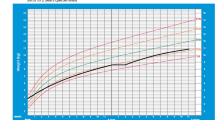Abstract
A case of a 5-year-old girl is described whose clinical features included postnatal growth retardation, microcephaly and characteristic facial appearance. These are recognized as the main features of the Dubowitz syndrome. Apart from these features, our patient had recurrent infections of the sinopulmonary tract, high serum IgE levels, defective chemotaxis of polymorphonuclear cells and defective antibody response, findings characterizing the hyper-IgE syndrome. The co-existence of these two syndromes is rare and we suggest that this is the first such case in the literature.
Conclusion
Patients with the Dubowitz syndrome will require long-term follow up because there is a considerable risk for the syndrome to co-exist with primary immunodeficiency or formalignancies to develop.
Similar content being viewed by others
References
Berthold F, Fuhrmann W, Lampert F (1987) Fatal aplastic anaemia in a child with features of Dubowitz syndrome. Eur J Pediatr 146:605–607
Buckley RH (1989) Disorders of the IgE System. In: Stiehm ER (ed) Immunological disorders in infants and children. WB Saunders, Philadelphia; pp 320–326
Dubowitz V (1965) Familial low birth weight dwarfism with an unusual face and a skin eruption. J Med Genet 2:12–17
Ilyina HG, Lurie IW (1990) Dubowitz syndrome: possible evidence for a clinical subtype. Am J Med Genet 35:561–565
Leung DY, Geha RS (1988) Clinical and immunologic aspect of the hyperimmunoglobulin E syndrome. Hematol Oncol Clin North Am 2(1):81–100
Lyonnet S, Schwartz G, Gatin G, Yves de Prost, Munnich A, Le Merrer M (1992) Blepharophimosis, eczema, and growth and developmental delay in a young adult: late features of Dubowitz syndrome? J Med Genet 29:68–69
Moller KT, Gorlin RJ (1985) The Dubowitz syndrome: a retrospective. J Craniofac Gen Develop Biol [Suppl 1]: 283–286
Sauer O, Spelger G (1977) Dubowitz Syndrome mit Immundefizienz und malignem Neoplasma bei zwei Geschwistern. Monatsschr Kinderheilkd 125:885–887
Author information
Authors and Affiliations
Rights and permissions
About this article
Cite this article
Antoniades, K., Hatzistilianou, M., Pitsavas, G. et al. Co-existence of Dubowitz and hyper-IgE syndromes: A case report. Eur J Pediatr 155, 390–392 (1996). https://doi.org/10.1007/BF01955268
Received:
Accepted:
Issue Date:
DOI: https://doi.org/10.1007/BF01955268




